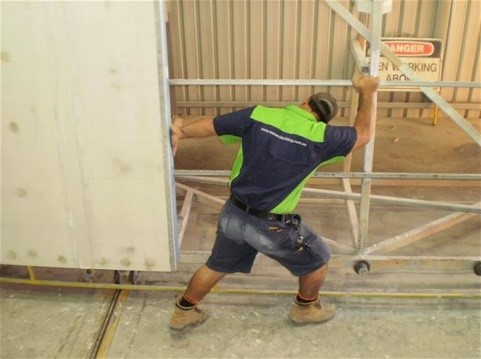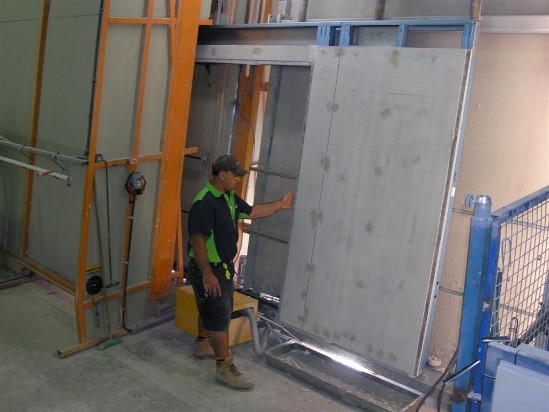Manually moving wall panels – Monarch Building Systems
Monarch Building Systems Pty Ltd manufactures and supplies building products for residential construction. It currently employs 22 workers.
Background
Monarch's products include wall panels with steel framing, external cladding, finishes, windows and doors, ready for site assembly and fit-out.
What was the hazardous manual task?
The hazardous manual tasks were identified on the production line of the wall panels.
Wall panels that are between three and seven metres in length need to be moved from one stage of production to the other, for example from framing to joints to drying to painting stations.
The system being used meant that in some areas of the production line workers had to lift the panels from one section to the next, and in other areas, workers used racks and rollers to pull the wall frames along the line.
Wear and tear from ongoing production, process line changes and machinery fatigue, meant that the different sections were at different heights and roller movement had deteriorated.
Who was involved?
Monarch was working with Workplace Health and Safety Queensland (WHSQ) during a metals audit campaign when the safety advisor and production manager at Monarch were first made aware of the PErforM program.
They researched the program then the safety advisor met with each senior operator to gain their support and train them in the PErforM process. A small team implemented and managed the PErforM program, referred to as the 'risk minimisation project'.
What were the risk factors?
The PErforM risk assessment worksheet identified that manually moving the panels required maximum forceful exertions and very uncomfortable awkward postures through the shoulders, back and hands.
The force used to initiate and sustain the panel movement was measured on a spring scale as high as 45–60 kilograms on one section of the line.

1: Moving panel before redesign
The team found significant resistance in the panel movement through contact with mid slide rails and a lack of contact with rollers in parts of the line. Different sections required greater exertion than others and a slight difference in the height between sections added to the need for forceful exertions.
What was the solution?
The team identified a section where the manual panel movement required almost no exertion or force and decided to replicate this section of the line.
The controls included:
- the slide bar was removed and vertical rollers were installed on the top of the drying chamber. The use of rollers significantly reduced the friction on the panels
- bottom rollers heights were adjusted
- wheels were lubricated.

2: Moving panel after controls.
Outcomes and benefits
The risk minimisation project used a systematic approach founded on management support and effective and open participation with the workforce to address manual tasks risks in the workplace.
The design changes to the panel line achieved a significant reduction in the need for forceful exertions and awkward postures. Using the spring scale, readings are now ranging between seven kilograms and 14 kilograms—a dramatic reduction from previous readings of as high as 60 kilograms.
The main benchmark used to identify the success of the program was lost time injuries. After Monarch identified hazardous manual tasks as the most significant
hazard in their workplace, and implemented the PErforM program, they incurred no lost time injuries over a twelve month period.
Other benefits of the program include:
- improved knowledge about manual tasks risks amongst the workforce. This is demonstrated through workers' communication to management about other manual tasks being performed in the workplace
- improved work health and safety performance and legislative compliance
- improved workplace safety culture and confidence in speaking out about issues.